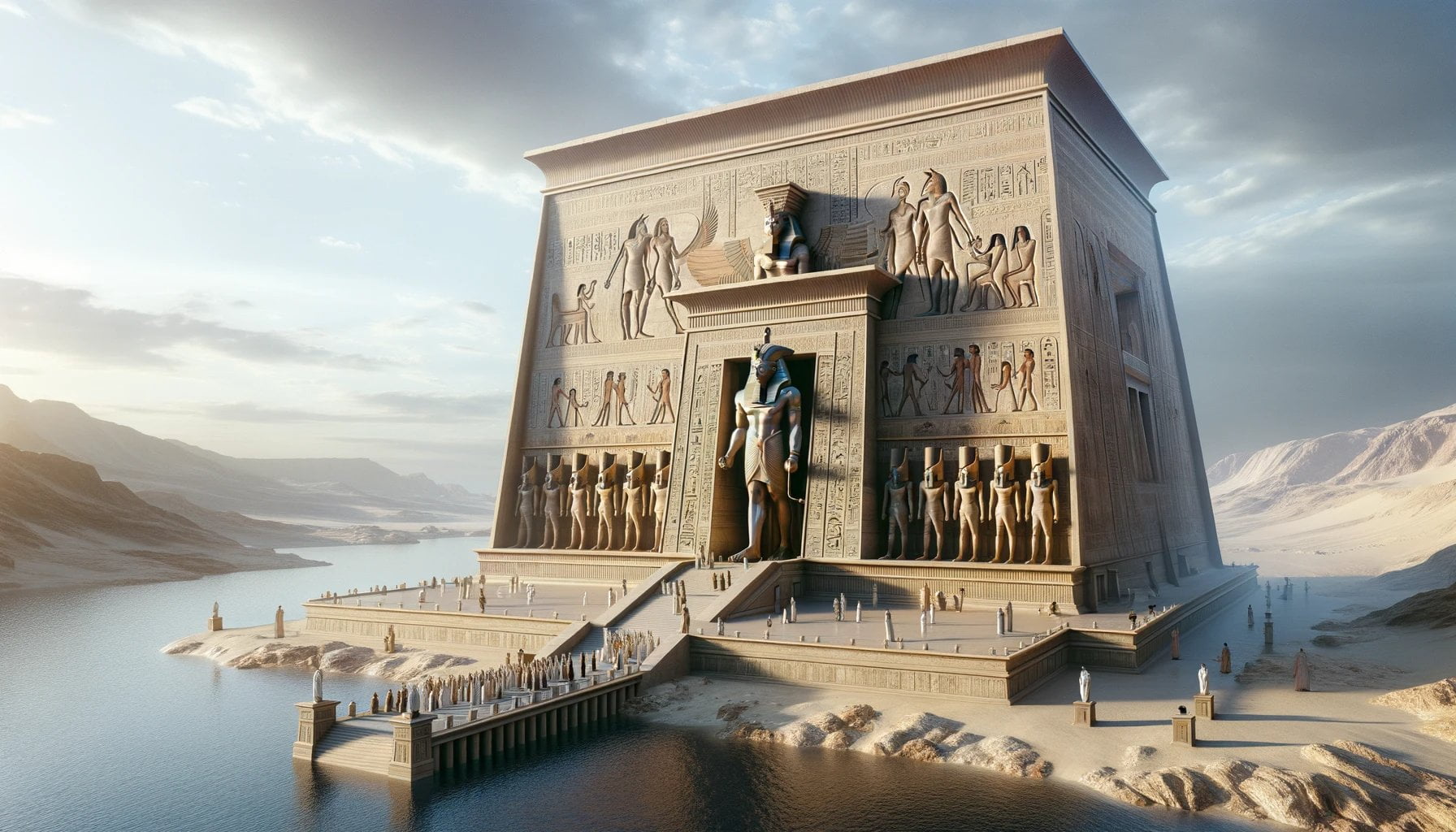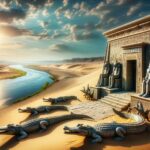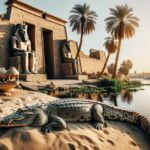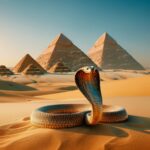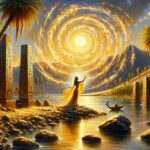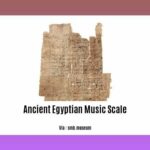Welcome to “Unveiling the Enigmatic Horus: Ancient Egypt’s Omnipotent Deity,” where we embark on a captivating journey through the mystical realms of ancient Egyptian culture. In this extraordinary exploration, we delve into the enigmatic world of Horus, an omnipotent falcon-headed deity revered throughout Ancient Egypt. With my expertise as a seasoned researcher and historian of ancient Egyptian culture, we uncover the fascinating religious significance and mythology surrounding Horus, shedding light on his role as a symbol of divine kingship and protector of the Pharaohs. Join me as we unravel the timeless allure and prevailing influence of Horus, transporting ourselves back to a time when this iconic figure reigned supreme.
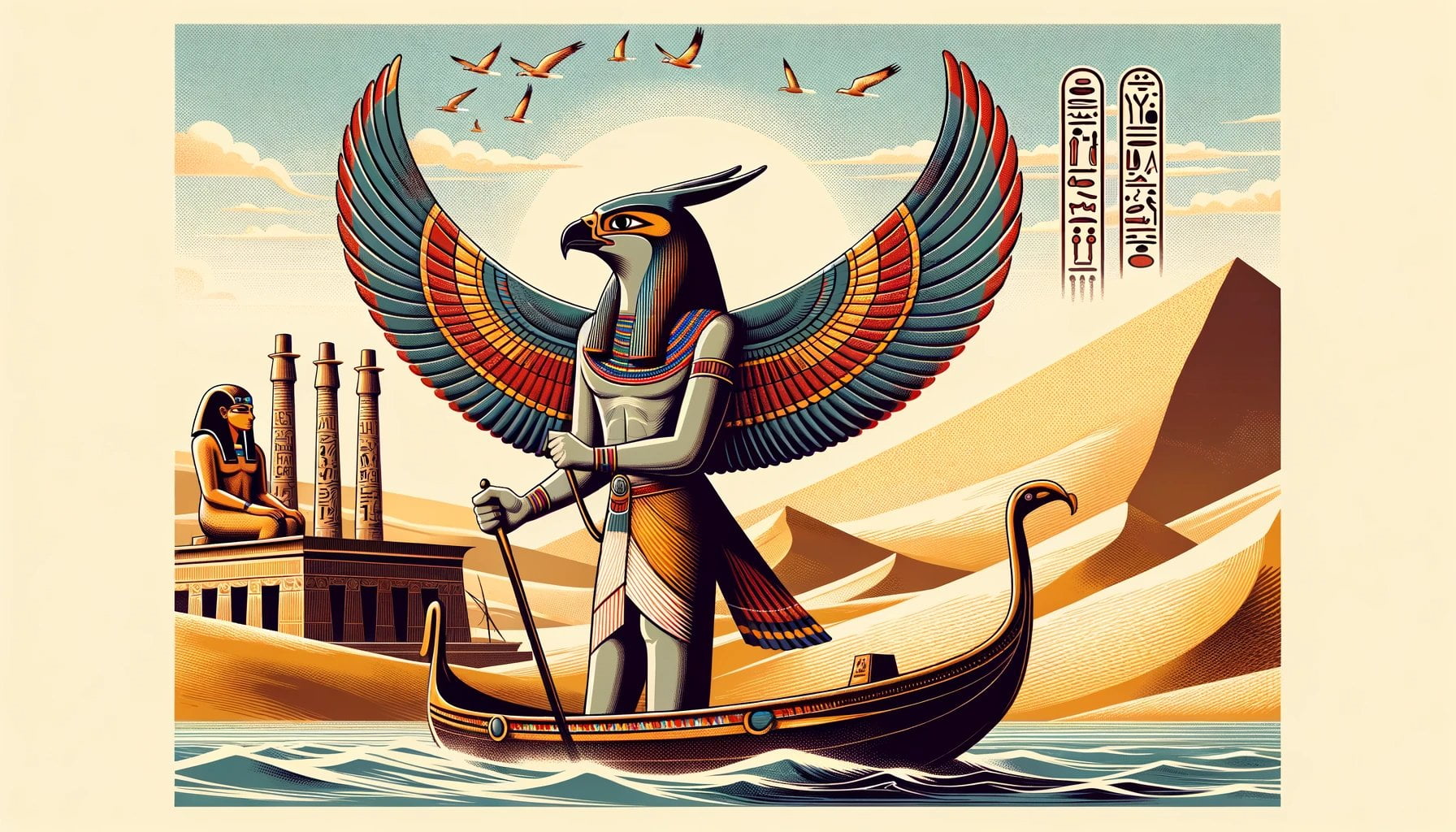
Key Takeaways:
- Horus is an ancient Egyptian god associated with various functions such as the sky, sun, kingship, healing, and protection.
- Horus is depicted as a falcon or a man with a falcon head.
- There are two main aspects of Horus: Horus the Elder and Horus the Younger, with the latter being the son of Osiris and Isis.
- Horus was worshipped in ancient Egypt from the late prehistoric period until the Roman era.
- He was involved in a conflict with Seth, the god of chaos and disorder.
- Horus was initially viewed as the god of war and the sky, but later portrayed as the son of Osiris and Isis, as well as the opponent of Seth.
- Horus was married to the goddess Hathor.
- Sources for more information about Horus include Wikipedia, Britannica, the Egyptian Museum website, and World History Encyclopedia.
Horus Ancient Egypt
Horus, the fascinating deity of Ancient Egypt, has enthralled historians and researchers for centuries. This powerful falcon-headed god played multiple roles, including being the god of the sky, sun, kingship, healing, and protection. As we delve into the mystique surrounding Horus, we uncover the deep-rooted mythology and religious significance tied to this omnipotent figure in ancient Egyptian culture.
The Tale of Horus: A Divine Saga
Horus’s story encompasses two distinct aspects. First, we have Horus the Elder, considered one of the foundational gods of the ancient Egyptian pantheon. Then there is Horus the Younger, the son of Osiris and Isis, who would emerge as a prominent figure in Egyptian mythology. Throughout the ages, Horus transformed from a god of war and the sky to one who symbolized divine kingship and served as a protector of the Pharaohs.
The Conflict with Seth: An Eternal Struggle
No tale of Horus would be complete without the mention of Seth, the god of chaos and disorder. According to ancient Egyptian beliefs, Horus and Seth found themselves locked in an eternal struggle for power and control. This conflict, epitomizing the battle between order and chaos, became a central theme in Egyptian mythology.
Unearthing Horus’s Symbols and Appearance
Horus is often depicted in the form of a falcon or as a man with a falcon head, representing his connection to the sky and the divine. He was revered not just as a powerful god, but also as a symbol of protection and healing. Horus’s story intertwines with other deities and mythological characters, such as his marriage to the goddess Hathor and his role as the son of Osiris and Isis.
Seeking Further Knowledge on Horus
For those eager to explore more about Horus, there are abundant resources available. Websites such as Wikipedia, Britannica, the Egyptian Museum website, and the World History Encyclopedia offer detailed insights into Horus’s life, appearance, symbols, and the context surrounding his worship in ancient Egypt.
Unlocking the Timeless Allure of Horus
As we peel back the layers of time, the allure of Horus remains undiminished. His stories and symbols have transcended millennia, captivating and fascinating people across the ages. From his beginnings as a god of war to his portrayal as a divine king and protector, Horus’s influence on Egyptian culture is undeniable.
Conclusion
Horus, the enigmatic deity of Ancient Egypt, continues to bewitch scholars and enthusiasts alike. Through meticulous research and an understanding of ancient hieroglyphics, we delve into the vast mythology and religious significance of this falcon-headed god. By shedding light on Horus’s role as a symbol of divine kingship and protector of the Pharaohs, we invite readers to journey back to a time where Horus reigned supreme, forever leaving an indelible mark on the history of Ancient Egypt.
The ancient temples of Egypt hold centuries of mystery and wonder. Journey through these magnificent structures and uncover the secrets of the pharaohs. Explore the inscriptions, statues, and breathtaking architecture that tell the fascinating tales of this ancient civilization. Discover more about the Ancient Temples of Egypt here.
The Symbols and Representations of Horus in Ancient Egyptian Art and Hieroglyphics
Horus, the revered deity of ancient Egypt, is a figure that has captivated scholars and history enthusiasts for centuries. The symbols and representations associated with Horus in ancient Egyptian art and hieroglyphics offer a fascinating glimpse into the religious beliefs and cultural practices of this ancient civilization.
The Falcon-Headed God and His Eyes
One of the most recognizable symbols of Horus is his falcon-head, representing his connection to the sky and the divine. This distinctive depiction of Horus is seen across various artistic representations and hieroglyphics.
Horus is often depicted with two different eyes, each representing a celestial body. His right eye, known as the “Eye of Ra,” symbolizes the sun, while his left eye, known as the “Eye of Horus” or the “Eye of the Moon,” represents the moon.
Horus as a Symbol of Divine Kingship
In ancient Egypt, the reigning king in Nekhen (Hierakonpolis) was believed to be a manifestation of Horus. This association highlights the god’s connection to divine kingship and the belief that the pharaohs were divinely appointed rulers. The imagery of Horus is often incorporated into royal regalia and used to represent the authority and legitimacy of the pharaoh.
The Eye of Horus: Symbol of Protection and Power
The Eye of Horus holds immense religious and mythological significance in ancient Egyptian culture. It is often depicted as a stylized eye, resembling the eye of a falcon. This powerful symbol was believed to bring protection and royal power.
Images of Horus’ mother, Isis, and other deities associated with her, often feature the Eye of Horus as a symbol of their own protective and nurturing qualities. The Eye of Horus has also been metaphorically interpreted as a symbol of insight, truth, or the mind’s eye.
The Fractional Symbolism of the Eye of Horus
The Eye of Horus is not only a symbol of protection but also has concrete practical applications in ancient Egypt. The fractions within the Eye of Horus symbol were used as a measuring unit for grains and flour. These fractions allowed for precise measurements in agriculture and commerce.
Furthermore, the Eye of Horus was also invoked for protection against eye diseases, reflecting the belief in the god’s healing powers. This symbol was considered a potent talisman against afflictions of the eye.
Horus’ Varied Representations
Horus is depicted in various forms in ancient Egyptian art and hieroglyphics, showcasing the versatility and multifaceted nature of this deity. Alongside his falcon-headed form, Horus is also represented as a lion, a hawk, and even a sphinx. These different representations further emphasize his connection to the sky, war, and protection.
The Enduring Influence of Horus
Horus was one of the most important deities in ancient Egyptian religion and was idolized throughout the civilization. His influence extended beyond religious practices and permeated various aspects of society, including the association with the pharaohs, dedicated temples, and cults.
The stories, symbols, and representations of Horus continue to captivate people to this day. The enigmatic nature of Horus, coupled with his importance in ancient Egyptian culture, ensures that he remains an enduring figure in our understanding of this ancient civilization.
Key Takeaways:
- Horus, the falcon-headed god of ancient Egypt, had multiple representations, including a falcon, a lion, a hawk, and a sphinx.
- His eyes, the “Eye of Ra” and the “Eye of Horus,” represent the sun and the moon, respectively.
- Horus represented divine kingship, with the reigning king in Nekhen believed to be a manifestation of the deity.
- The Eye of Horus symbolizes protection, royal power, insight, truth, and the mind’s eye.
- It was also used as a measuring unit for grains and flour, and invoked for protection against eye diseases.
- Horus had a significant influence on ancient Egyptian culture, with dedicated temples and cults devoted to him, and his symbols continue to captivate people to this day.
The Role of Horus in Egyptian Religion and Worship
Horus, the illustrious falcon-headed deity of ancient Egypt, played a profound role in the religious beliefs and worship practices of the Egyptian people. As the god of the sky and the sun, Horus held a position of immense power and importance in the ancient Egyptian pantheon. But his significance extended far beyond that of a celestial guardian. Horus was also revered as the protector of the Egyptian people and the pharaohs, embodying the principles of divine kingship and providing a sense of order and stability to the Egyptian understanding of the natural world and the divine.
The Power of the Divine Sun
In the vibrant tapestry of Egyptian life, the sun held a pivotal role, symbolizing life, energy, and renewal. Horus, as the god of the sky and the sun, embodied this elemental force. His radiant presence permeated every aspect of ancient Egyptian culture, instilling a sense of awe and reverence among the people.
Provider and Protector
Beyond his association with the sun and the sky, Horus served as a provider and protector for the Egyptian people. His unwavering support and guardianship extended to the pharaohs, who were believed to be divinely appointed rulers. In times of uncertainty and danger, the people looked to Horus for guidance and protection, relying on his benevolent presence to safeguard them from harm.
The Legend of Horus and Set
One of the most enduring tales in Egyptian mythology revolves around the cosmic struggle between Horus and Set. Set, the god of chaos and disorder, posed a constant threat to the balance and harmony established by the sun god Ra. Horus, in his role as the divine defender, engaged in an eternal battle with Set to uphold order and protect the land of Egypt. This mythic conflict not only served as a source of inspiration and guidance for the ancient Egyptians but also reinforced their belief in the triumph of good over evil.
Symbol of Divine Kingship
Horus’s association with the pharaohs went beyond mere protection. He embodied the concept of divine kingship, cementing the belief that the rulers of Egypt were chosen by the gods and held a direct connection to the divine. This sacred bond between Horus and the pharaohs further legitimized the ruler’s authority and allowed the people to place their trust and allegiance in their chosen leader.
Key Takeaways:
- Horus, the falcon-headed deity, played a significant role in ancient Egyptian religion and worship.
- He was revered as the god of the sky and the sun, symbolizing the power and importance of these celestial elements in Egyptian life.
- Horus served as a provider and protector for the Egyptian people, especially the pharaohs.
- The legend of Horus and Set provided stability and order to the Egyptian understanding of the natural world and divine powers.
- Horus served as a symbol of divine kingship, reinforcing the belief that the pharaohs were divinely appointed rulers.
Through the captivating legends and timeless symbols associated with Horus, we catch a glimpse into the profound religious and cultural influence he held over the ancient Egyptians. The enigmatic deity continues to intrigue and inspire us to this day, reminding us of the enduring power and influence of the ancient Egyptian civilization.
The Legacy of Horus: His Influence on Ancient Egyptian Society and Beyond
The deity Horus holds a significant place in the ancient Egyptian pantheon, serving as a symbol of divine kingship, protection, and healing. His legacy extends far beyond the borders of Egypt, leaving an indelible mark on ancient society and continuing to captivate people to this day. Let’s delve into the enigmatic world of Horus and explore his enduring influence.
Horus and Divine Kingship
In ancient Egypt, the reigning king at Nekhen (Hierakonpolis) was believed to embody the spirit of Horus, playing a pivotal role in maintaining order and ensuring the prosperity of the kingdom. Horus was revered as the god of kingship, symbolizing the divine right of the pharaohs to rule. His influence extended beyond the earthly realm, creating a link between the mortal ruler and the cosmic order.
Horus as a Protector and Healer
Horus’ role as a protector is deeply ingrained in ancient Egyptian society. He was venerated as a guardian deity, watching over the pharaohs and offering his divine protection to all. Horus’ association with healing further solidifies his position as a benevolent force within the pantheon. Individuals would seek his assistance for physical and spiritual well-being, believing in his ability to bestow blessings and restore harmony.
Horus in Myths and Symbolism
One of the most enduring myths involving Horus is the story of his parents, Osiris and Isis, and his battle with Seth, the god of chaos. Horus, as the son of Osiris and Isis, played a crucial role in avenging his father’s death and reclaiming the throne from Seth. This myth serves as a testament to the eternal struggle between good and evil, emphasizing the triumph of order over chaos.
The Eye of Horus, a powerful symbol associated with the deity, represents the restoration of his eye by the goddess Hathor after a fierce battle with Seth. This symbol carries profound meaning, signifying protection, power, and the restoration of balance. Its use in ancient Egyptian society extended beyond the realm of mythology, with the fractions within the Eye of Horus symbol serving as a measuring system for grains and flour.
Horus’ Enduring Influence
Horus held a prominent place in Egyptian worship, with dedicated temples and cults devoted to his worship. The city of Idfu, in particular, revered him as its chief god, highlighting the deity’s pervasive influence throughout the land. Even after the decline of ancient Egypt, Horus’ impact continues to resonate. His stories and symbols have captivated people throughout history, and his depiction as a falcon-headed god remains one of the most recognizable icons of Egyptian mythology.
Key Takeaways:
- Horus symbolized divine kingship and played a vital role in maintaining order within ancient Egyptian society.
- As a protector and healer, Horus offered his divine assistance to both pharaohs and individuals seeking wellbeing.
- Horus’ myths, particularly his battle with Seth, reaffirmed the triumph of good over evil and the restoration of balance.
- The Eye of Horus, a powerful symbol, represented protection, power, and the restoration of harmony.
- Horus’ influence extended beyond ancient Egypt, captivating people throughout history and leaving an enduring legacy.
References:
Ancient Egypt. (n.d.). https://education.nationalgeographic.org/resource/resource-library-ancient-egypt/
Bowman, A. K., Wente, E. F., Dorman, P. F., Samuel, A. E., & Baines, J. R. (2023, September 30). Ancient Egypt | History, Government, Culture, Map, & Facts. Encyclopedia Britannica. https://www.britannica.com/place/ancient-Egypt
Ancient Egypt. (2023, September 27). Wikipedia. https://en.wikipedia.org/wiki/Ancient_Egypt
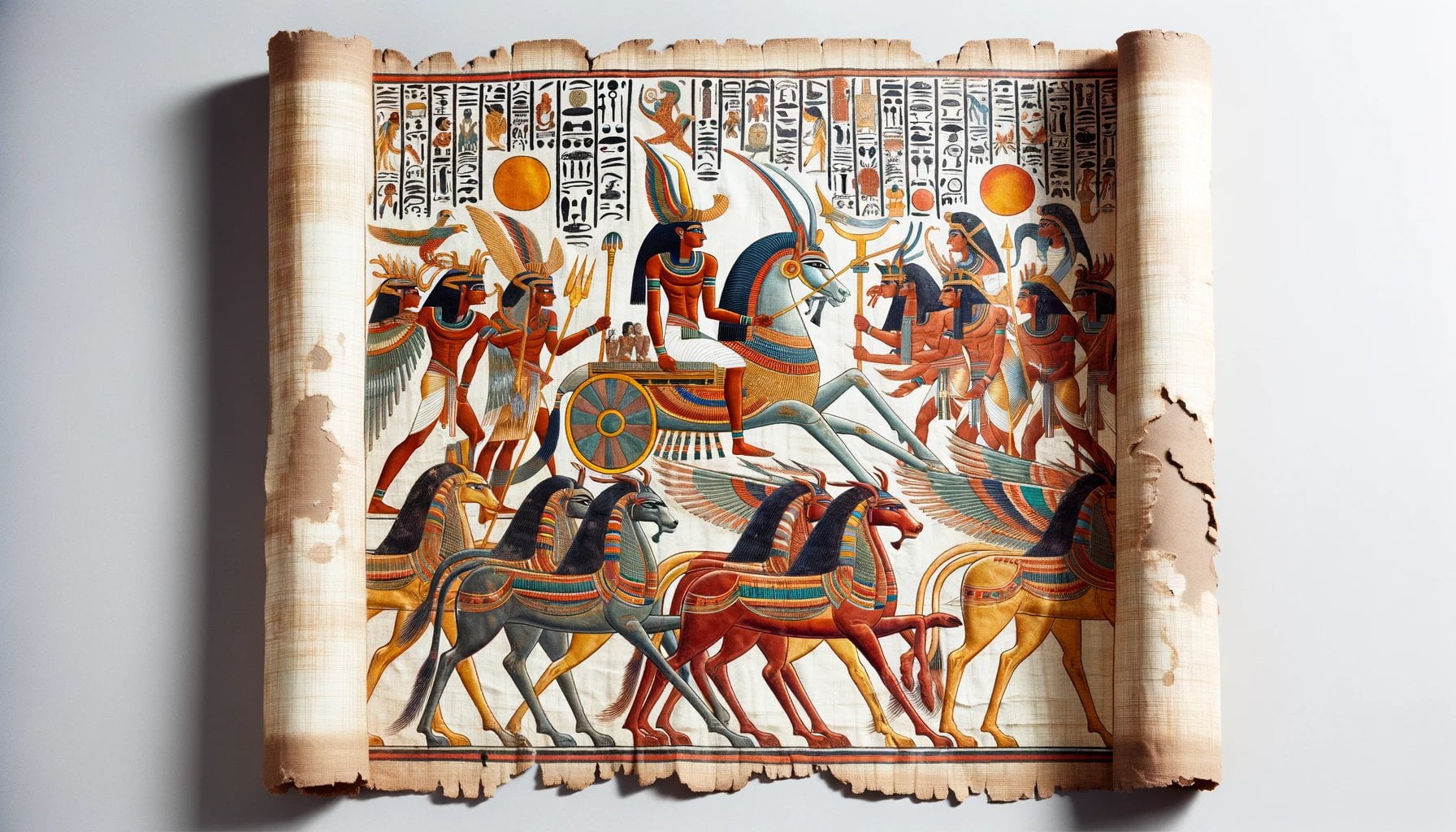
FAQ
Q1: Who is Horus in ancient Egyptian mythology?
A1: Horus is an ancient Egyptian god depicted as a falcon. He served multiple functions, including being the god of the sky, sun, kingship, healing, and protection.
Q2: What are the main aspects of Horus?
A2: There are two main aspects of Horus: Horus the Elder, who was one of the first five gods, and Horus the Younger, who was the son of Osiris and Isis.
Q3: What is the significance of Horus in ancient Egyptian religion?
A3: Horus was one of the most important deities in ancient Egyptian religion. He was associated with the sky and war, and was worshipped from the prehistoric period until the Roman era.
Q4: What is the Eye of Horus?
A4: The Eye of Horus is a symbol associated with Horus. It represents the restoration of his eye by Hathor after a struggle with Seth. It is also used metaphorically to symbolize insight, truth, or the mind’s eye.
Q5: How did Horus influence ancient Egyptian society?
A5: Horus was idolized by the ancient Egyptians as a symbol of prosperity and protection. He was associated with the pharaohs and had temples and cults dedicated to him. His role as a protector and divine king provided stability and order in Egyptian society.
- Sept 31 Myth: Unveiling Calendar Secrets - March 18, 2025
- How Long & Till December 18, 2025: Accurate Countdown Guide - March 18, 2025
- Discover Japanese Artists: A Complete History - March 18, 2025
